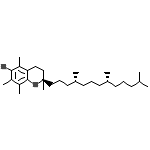Tocopherol




Tocopherol Brand names, Tocopherol Analogs
Tocopherol Brand Names Mixture
- No information avaliable
Tocopherol Chemical_Formula
C29H50O2
Tocopherol RX_link
No information avaliable
Tocopherol fda sheet
Tocopherol msds (material safety sheet)
Tocopherol Synthesis Reference
No information avaliable
Tocopherol Molecular Weight
430.713 g/mol
Tocopherol Melting Point
2 oC
Tocopherol H2O Solubility
Insoluble in water, but water-dispersible.
Tocopherol State
light yellow liquid
Tocopherol LogP
9.959
Tocopherol Dosage Forms
Capsules, Tablets, Chew tablets, Drops, Ointment, Cream, Lotion, Oil
Tocopherol Indication
Vitamin E, known for its antioxidant activities, is protective against cardiovascular disease and some forms of cancer and has also demonstrated immune-enhancing effects. It may be of limited benefit in some with asthma and rheumatoid arthritis. It may be helpful in some neurological diseases including Alzheimer's, some eye disorders including cataracts, and diabetes and premenstrual syndrome. It may also help protect skin from ultraviolet irradiation although claims that it reverses skin aging, enhances male fertility and exercise performance are poorly supported. It may help relieve some muscle cramps.
Tocopherol Pharmacology
Vitamin E has antioxidant activity. It may also have anti-atherogenic, antithrombotic, anticoagulant, neuroprotective, antiviral, immunomodulatory, cell membrane-stabilizing and antiproliferative actions. Vitamin E is a collective term used to describe eight separate forms, the best-known form being alpha-tocopherol. Vitamin E is a fat-soluble vitamin and is an important antioxidant. It acts to protect cells against the effects of free radicals, which are potentially damaging by-products of the body's metabolism. Vitamin E is often used in skin creams and lotions because it is believed to play a role in encouraging skin healing and reducing scarring after injuries such as burns. There are three specific situations when a vitamin E deficiency is likely to occur. It is seen in persons who cannot absorb dietary fat, has been found in premature, very low birth weight infants (birth weights less than 1500 grams, or 3½ pounds), and is seen in individuals with rare disorders of fat metabolism. A vitamin E deficiency is usually characterized by neurological problems due to poor nerve conduction. Symptoms may include infertility, neuromuscular impairment, menstrual problems, miscarriage and uterine degradation. Preliminary research has led to a widely held belief that vitamin E may help prevent or delay coronary heart disease. Antioxidants such as vitamin E help protect against the damaging effects of free radicals, which may contribute to the development of chronic diseases such as cancer. It also protects other fat-soluble vitamins (A and B group vitamins) from destruction by oxygen. Low levels of vitamin E have been linked to increased incidence of breast and colon cancer.
Tocopherol Absorption
50 to 80% absorbed from gastrointestinal tract.
Tocopherol side effects and Toxicity
No information avaliable
Tocopherol Patient Information
• Take with or after meals.
Tocopherol Organisms Affected
Humans and other mammals














